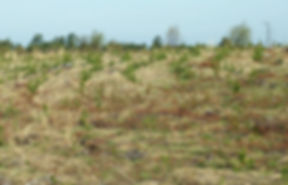March 31, 2024, is a special day for us because it’s the 10th anniversary of our first meeting as we sought to form a new nonprofit organization with a mission of advancing Kirtland’s Warbler conservation.
At least we think today is our anniversary. It’s the 10th anniversary of the oldest meeting agenda in our files. But there were lots of pre-meeting meetings to plan what would happen at the first official meeting so the decision to call the Jan. 31 date our anniversary is a little arbitrary.
On Jan. 31, 2014, a handful of people gathered in a basement conference room at Treetops Resort in Gaylord, Michigan. There was a retired DNR employee, a member of the Board of Huron Pines, our parent organization, an employee of the U.S. Fish and Wildlife Service, an employee of the Kalamazoo Nature Center, an author, and an ardent conservationist whose father was instrumental in Kirtland’s Warbler conservation in the 1960s and ‘70s. There is proof of the meeting – a group photo – somewhere in our files. We hope to share it with you … if we can ever find it.
The vision for the Alliance came out of an academic paper written by J. Michael Scott and Carol Bocetti, two professors who specialized in endangered species conservation. As part of his work conserving California Condors, Prof. Scott realized that 80 percent of endangered species could not be removed from the Endangered Species List because they were reliant on active and continuing conservation efforts by humans to prevent their extinction. There was no mechanism to support these species after recovery. Therefore, they could not be removed. It was as if they were on life support.
What if, Scott and Bocetti wondered in their paper, an organization could be set up that would provide financial support for those unending conservation efforts? The Alliance was born with that concept in mind. The are proud to be part of this first-ever effort.
Over the past decade our mission has been refined as we have focused in on certain key areas where we can play a critical role to promote Kirtland’s Warbler conservation.
In those earliest days we were guided – no, we were driven – by Abby Ertel, who is in charge of community outreach for Huron Pines.
If you have never met Abby, the best way to describe her is a force of nature crossed with a den mother. Perhaps her words describe that first meeting best:
“What I remember most was the energy and excitement in the room as we gathered for that first meeting. We had scheduled it for the day ahead of our Huron Pines annual meeting which was fun - it meant bringing new faces, energy and ideas to our organization. It also meant showcasing our skills and perspective in new arenas as well. We were all new to each other and little unsure about what exactly we would be doing - however we all shared an understanding of how important and historic the task ahead of us was going to be for KW.
“Looking back on that day it comes through in my memories with almost a warm, cinematic filter - with a soft glow and richness. I didn't know it then but I made some of my best personal and professional memories, connections and relationships working with the Alliance and KW partners, doing fun and challenging work for a rare bird and forest system that was literally in my back yard, out my window. We also learned a lot about community engagement and sustaining conservation efforts during that time period which has had direct positive benefits for conservation and communities in Northern Michigan.
“How can you not get the warm fuzzies?!”
Warm fuzzies, indeed. Especially when we think of those who have been Board members guiding lights along the way. Some have moved on to other things. Some are still with us, while one particularly beloved member has left this mortal coil. (We miss you, Jerry!)
Most importantly, over the past decade we have built an organization that has the respect of our partners in the community, among other non-government organizations and with the conservation agencies inside the state and federal government.
Most importantly, we have to thank you, our donors, supporters and volunteers, for all you have done to boost our mission over the past decade. There’s no doubt it has been a challenge, but we’re looking forward to another 10 years of meeting challenges and overcoming them for the benefit of our favorite half-ounce of feathers.



